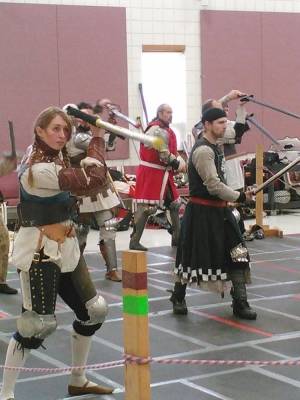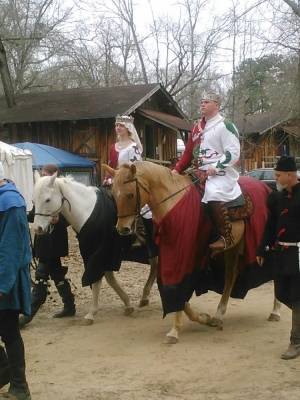This Saturday, get ready to experience a revival of the Middle Ages and Renaissance as interactively and creatively as you could ever imagine. On November 22nd, from 9 a.m.-7 p.m., the Champaign branch of the Society for Creative Anachronism, Inc. (SCA) will be hosting the Royal University of the Midrealm (RUM). Bringing together makers, artisans, reenactors, and experimental archeologists from all over the Midwest, the convention will offer a series of hands-on workshops and classes. Among the classes being offered: blacksmithing, jewelry making, stained glass, glassworking, weaving, garment construction, woodworking, and dozens more. This is an event unlike any other, and a time where attendees will have the rare opportunity of learning some exceptionally unique skills.
Dena Strong and Roana Isenholt, two members of the Champaign branch of the SCA, were kind enough to share some more information about the event. Strong will be hosting a class at the event herself, and Isenholt is the event organizer.
———
Smile Politely: Dena, can you tell me about the class that you’ll be teaching at RUM?
Dena Strong: I’m teaching a course in making spiral wire of a sort that was found in an international trading center in Sweden called Birka in the ninth century. It’s kind of an obscure sort of thing that’s just one of many, many things I’m interested in. It’s just that it’s the most obscure thing I know so I wanted to teach more people about it.
SP: Would you say that most of the people who are teaching a class or running a workshop self-taught these skills to themselves?
Roana Isenholt: Yeah, a lot of them. I’ve done mostly research by myself to learn it. Sometimes I take outside classes, but most of the time I can’t. There is a book binding class this RUM, but it’s the first book binding class they’ve had at RUM in years. But I love book binding, and so how do you do it if you don’t have those resources? So you have a lot of self-teaching, a lot of, “Oh! You’re interested in book binding, too? Well, here—this is what I’ve been doing. Wow! How did you get that to happen? Oh, well, I did this. Wow, well, when I did that, this is what happened.” There’s a lot of back and forth. You get a group of—for a lack of a better term—you get a group of geeks together, and they geek out, and they all learn something, and they walk away feeling better for it. And that’s kind of what we’re anticipating happening with RUM.
SP: What can you say about this event to entice people who don’t necessarily have an interest in the Middle Ages or the Renaissance?
Isenholt: If you have any interest in learning how things are made, even things that you just don’t think about, and all of a sudden you’re like, “Wow, hey, I could make that,” this is the event to go to.
Strong: If you’ve ever broken a window and thought, “Hey, it would be awesome to have a little piece of stained glass art in there.”
Isenholt: Or brewing! I mean, brewing is a really common thing out there now, and there are so many people who want to brew. Well, there’s a beginning brewer class at this. If you wanted to do it, stop in! And if you want to introduce your kids to the idea of making or doing things themselves, there are youth classes happening as well. It’s a fun way for the whole family to do something interesting and outside of the mainstream. It’s not going to the movies. It’s interactive. You’re a part of it. And that’s hard to find—something where you’re an active participant in something interesting.
SP: That’s what caught my attention, that I would be able to participate in it. And there are just so many crafts you get to try and activities that I don’t think I would have the opportunity to learn anywhere else. So how will the day be structured and how long is each class supposed to take?
Isenholt: Most classes run about an hour, but there are some classes that go as long as two or three hours, depending on what they’re teaching. But then there are other things where you can just stop in and see what they’re doing and leave. Most of the classes run from 10 a.m.-5 p.m. and they’re typically in one-hour blocks. We have about five classrooms going every hour, just for the arts and sciences.
Strong: There are another four for the youth and three laid out for martial. Most classes will be hands-on, and people will be able to take home what they make.
SP: What would you say is the most rewarding part of organizing or participating in RUM?
 Isenholt: The most rewarding part of it is when I’m standing there that day and everybody is having fun. It doesn’t matter what fires have to be put out — and there are always fires that have to be put out. The important thing is that people don’t know that there are fires that need to be put out, but that everybody is having a good time.
Isenholt: The most rewarding part of it is when I’m standing there that day and everybody is having fun. It doesn’t matter what fires have to be put out — and there are always fires that have to be put out. The important thing is that people don’t know that there are fires that need to be put out, but that everybody is having a good time.
Strong: For me, the SCA is all of the artistic stuff that I’ve wanted to do for many, many years and not found an outlet for. You participate, you learn, and you get to make new stuff. I really love the idea of starting with, “Hey, here’s a picture in a book. I wonder how to make that.” Three months later, “Hey, look at this thing I made.” Three months after that, “Hey, this is how you can make that thing, too.” I love that progression.
SP: What is one workshop or class that you believe is underrated or deserves more recognition?
Isenholt: I would say the history classes are the most underrated. We rarely have history classes, but this year there are several. There is going to be a class on medieval code cracking, one on Æthelred the Unready and another on Harold Godwinson. And you don’t usually get classes that are specific to history, as odd as that sounds. Having a class on specific historical instances is unusual, and I believe it’s sorely lacking and something that I would like to see more of.
SP: Lastly, what do you hope attendees will walk away with after attending RUM?
 Isenholt: That they have fun! The whole point is that they came and that it was worth it, that they were glad that they came and walked away feeling like it was a positive experience.
Isenholt: That they have fun! The whole point is that they came and that it was worth it, that they were glad that they came and walked away feeling like it was a positive experience.
Strong: I want people to walk away with something that they made that they didn’t think that they could make. With the confidence that, “Hey, I can learn this stuff, too!” and with the knowledge that, “Hey, there’s this group of people out there who are interested in learning all this stuff.” We’re willing to support you and help you learn all this stuff.
———
Admission for RUM costs $6 for members of the SCA and $11 for non-members. U of I students and children under 12 get in for free.
The SCA has weekly meetings on the second, third, and fourth Mondays of every month. The second and fourth Monday meetings are in the Illini Union from 7-9 p.m., while the third is either at a member’s house or the local Joann’s. Anyone is welcome to attend. More information about the Champaign branch of the SCA can be found on their Facebook page at or on their website.








